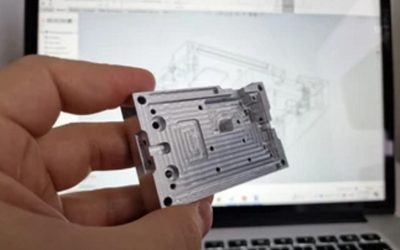6061 is a good all-around aluminum. You can weld it easily, and doesn’t cost a lot. Think of it like the aluminum you might find in a car door. 7075 is super strong, but it’s a pain to weld. That makes it pricier. This is the stuff they use in airplanes because it needs to be extra tough.
The main difference between them is what other metals are mixed in. 7075 has more zinc, which makes it stronger.
Strength:
- 7075 is way stronger than 6061. It can handle much heavier loads before bending. Think of it like comparing a thick steel bar to a thin one.
Toughness:
- 7075 is also tougher. It takes more force to break it. Imagine trying to snap a twig versus a thick branch.
Fatigue Life: A material can resist repeated loading and unloading cycles.
II. 6061 Aluminum Simple Explanation
6061 aluminum is an instrumental metal. It is strong but not too heavy. This makes it good for many different things.
What is 6061 Made Of?
6061 aluminum is mostly aluminum. But it also has other things in it:
- Magnesium: This makes it stronger.
- Silicon: This also makes it stronger and helps it resist corrosion (rusting).
When magnesium and silicon mix in 6061, they form magnesium silicide, which gives 6061 its special properties.
Why is 6061 Useful?
6061 Aluminum is useful because it is strong and light. This means you can use it to make things that need to hold weight but not be too heavy.
What is 6061 Used For?
6061 is used for many things, like:
- Cars: Parts of car frames and bodies.
- Buildings: Window frames and supports.
- Boats: Parts of boat hulls and decks.
- Bikes: Bicycle frames.
Die Casting with 6061 Aluminum: Simple Steps
Suppose you are considering how you might make a car, out of metal. Be it, 6061 aluminum and die casting are used. It’s like creating a metal stereotype.
Here’s how it works:
- Melt the 6061: Bring 6061 aluminum to the point that it melts and turns into liquid like melted chocolate.
- Prepare the mold: You will have to make a strong metal mold of the toy car. Be sure that it’s clean and ready.
- Pour the metal: Allow the 6061 aluminum to melt on the table, and pour them into the mold carefully. Be sure that it fills up all the spaces.
- Let it cool: Wait for the metal to cool down and become solid. This might take a little while.
- Open the mold: Once the metal is hard, carefully open the mold.
- Take out your car: Your toy car is now ready! You might need to clean up any rough edges.
Why use 6061 T6 for Die Casting?
- Strong but light: 6061 is a good strong, yet not too heavy toy material.
- Doesn’t rust easily: Your toy car won’t rust easily, and 6061 is good at resisting corrosion.
- Easy to shape: Working with to make different shapes is easy.
Important things to remember:
- Be careful: Melted metal is scorching and can be dangerous. Always have an adult help you.
- Use the right tools: You’ll need special tools to melt the metal and handle the mold.
- Practice makes perfect: It might take a few tries to get it right, but don’t give up!
III. 7075 Aluminum: Simple Explanation
7075 aluminum is a very strong metal. It is also light. This makes it good for things like airplanes and rockets. These things need to be strong but not heavy.
What is 7075 Made Of?
7075 aluminum is mostly aluminum. But it also has other things in it:
- Zinc: Makes it strong.
- Magnesium: Helps it resist bending.
- Copper: Makes it extra strong and tough.
Looking Inside 7075
If we could look inside 7075 with a powerful microscope, we would see tiny crystals arranged in a pattern. This pattern makes 7075 very strong.
Making it Stronger with Heat
7075 is made even stronger with a process called heat treatment. This involves heating the metal and then cooling it down quickly. This makes the crystals inside lock together tightly.
Die Casting with 7075
Die casting is like making metal toys with a mold. We pour melted 7075 into a mold. The metal cools and hardens in the shape of the mold.
Here’s how it works:
- Melt the metal: Heat 7075 until it becomes liquid.
- Inject the metal: Push the liquid metal into a mold.
- Cool the metal: Let the metal cool and harden inside the mold.
- Remove the part: Open the mold and take out the finished part.
Why Use 7075 for Die Casting?
- Strong parts: 7075 makes parts that can handle a lot of force.
- Light parts: 7075 makes parts that are light in weight.
- Detailed parts: 7075 can make parts with very small details.
Challenges of Using 7075
- High melting point: It takes a lot of heat to melt 7075.
- Sticking to the mold: 7075 can sometimes stick to the mold.
- Special equipment: You need special machines to die cast 7075.
IV. Detailed Comparison of 6061 T6 and 7075
Chemical Composition:
| Alloy | Magnesium (%) | Silicon (%) | Zinc (%) | Copper (%) | Other Elements (%) |
| 6061 | 0.8-1.2 | 0.4-0.8 | <0.25 | 0.15-0.4 | Iron, Chromium |
| 7075 | 2.1-2.9 | <0.4 | 5.1-6.1 | 1.2-2.0 | Iron, Manganese |
The main difference between the two alloys concerns the main alloying elements that are present in it. Magnesium and silicon in 6061 make. It has moderate strength, high corrosion resistance, and good workability. While 7075 has a higher content of zinc and copper. It has better strength and therefore less corrosion resistance and is not very easy to weld either.
Mechanical Properties:
| Property | 6061-T6 | 7075-T6 |
| Yield Strength (MPa) | 276 | 503 |
| Tensile Strength (MPa) | 310 | 572 |
| Shear Strength (MPa) | 207 | 331 |
| Hardness (Brinell) | 95 | 150 |
7075 is stronger than 6061. Thus, it offers more desirable mechanical properties. Hence, it is ideal for chemical mixing in flight frames, aircraft parts, and other decoders. Nevertheless, 6061 is still very good for ordinary structural applications. It combines mechanical strength, and corrosion endurance. Netal fabrication is also easy.
Key Properties of 6061 T6 and 7075-T6
| Property | 6061-T6 | 7075-T6 |
| Yield Strength (MPa) | 276 | 503 |
| Tensile Strength (MPa) | 310 | 572 |
| Fatigue Strength (MPa) | 207 | 331 |
| Corrosion Resistance | Good | Fair |
| Machinability | Excellent | Good |
| Weldability | Excellent | Fair |
Machinability:
These two alloys are good in terms of machinability characteristics. While 6061 is normally used in machining applications due to its lower hardness. This also means it’s less hard to cut and shape. Therefore, cheaper to tool and less wear on the machinery. It’s still not grievously hard, but a little more difficult to machine than 7075.
Formability and Weldability:
7075 is cheaper than 6061. It’s also harder to bend and shape. You can’t easily weld 7075 together. 6061 t6 isn’t as strong as 7075, it’s easier to work with. You can bend it and weld it without any problem.
Corrosion Resistance:
6061 is easy to bend and shape. It’s like Play-Doh, but metal! It also doesn’t rust easily, even if you leave it outside in the rain.
7075 is much stronger, but harder to bend.
Both types of metal can be made even tougher with a special coating. This coating acts like a shield to protect them from rust and damage.
Anodizing:
Is 6061 and 7075 anodized? They can. But 6061 is preferred more for its anodized appearance. Its copper content causes it to produce a thicker, uniform oxide layer than 7075.
Density:
6061 is a more vulnerable alloy than 7075. The difference is that 6061 has additional alloys.
Thermal Conductivity:
T6061 has improved thermal conductivity than 7075. It can be applied to heatsinks and radiators.
Applications of 6061 T6 and 7075:
7075 Aluminum:
7075 aluminum is needed for industries that require maximum strength of the product. It’s commonly used in aerospace, defense, and military industries. High load and high stressed are typical operating conditions of such components. Examples are:
- Wings
- Fuselages
- Missiles
- Bicycles and climbing equipment.
6061 Aluminum:
Generally, 6061 is widely used in the automotive, construction, and marine industries. It has high tensile strength and anti-corrosive properties. The major applications are:
- Car frames
- Boat parts
- And beams and pillars.
Cost Considerations:
Many applications limit costs, so 6061 t6 is preferred to 7075 at a much lower price 6061 is cheaper than 7075. It’s strong and is really good for challenging applications. For everyday purposes, however, 6061 is best. The cost-performance trade-off is a critical decision criterion in material selection.
Conclusion:
7075 is the strongest. It’s great for tough jobs where the metal needs to handle a lot of stress. But it’s harder to work with and costs more.
6061 t6 is a good all-around choice. It’s strong, easier to work with, and cheaper.
Here’s a simple way to decide:
- Need maximum strength? Choose 7075.
- Need a balance of strength, cost, and ease of use? Choose 6061.





0 Comments